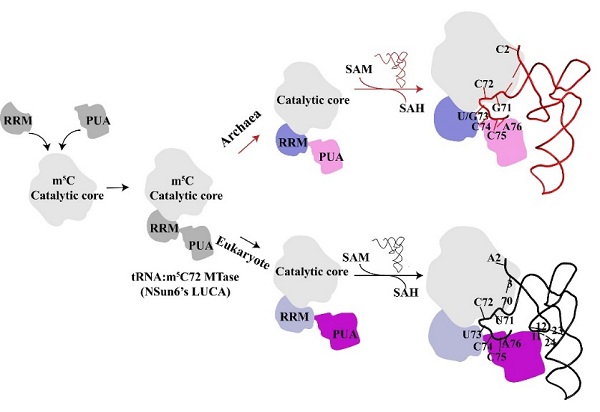Prof. En-Duo Wang’s group reveals the tRNA substrate specificity of archaeal NSun6
Source:
Time: 2018-12-17
On December 12, the international scientific journal《Nucleic Acids Research》online published the new work from En-Duo Wang’s group in Institute of Biochemistry and Cell Biology entiled “Archaeal NSun6 catalyzes m5C72 modification on a wide-range of specific tRNAs”
m5C72 is a newly identified modification in the acceptor stem region of human cytoplasmic tRNAThr and tRNACys, established on human NSun6 (hNSun6). Our previous study demonstrated the tRNA recognition elements and catalytic mechanism of hNSun6 (Long, T, et al, 2016, JBC; Liu, RJ and Long, T, et al, 2017, NAR). Intriguingly, hNSun6 homologs are present only in higher eukaryotes and hyperthermophilic archaea. In contrast to the well-studied identified genes that encode eukaryotic NSun6s, the corresponding genes in archaea are unknown. In archaeon Pyrococcus horikoshii OT3, the gene encoding the NSun6 homolog is PH1991. Compared with hNSun6, PH1991 possesses conserved catalytic residues, but has distinct differences in the predicted RNA recognition motifs. Until now, the properties and functions of PH1991 were uncharacterized.
Under the guidance of Professors En-Duo Wang and Ru-Juan Liu, Ph. D students Jing Li et al. showed that PH1991 is a tRNA:m5C72 MTase NSun6 (PhNSun6) and identified its tRNA substrates. Remarkably, PhNSun6 has a much wider range of tRNA substrates than hNSun6, attributed to its tRNA substrate specificity, which was further elucidated using biochemical and crystallographic experiments. Structurally, the binding pocket for nucleotide 73 in PhNSun6 is specific to accommodate U73 or G73-containing PhtRNAs. Furthermore, PhNSun6 lacks the eukaryotic NSun6-specific Lys-rich loop, resulting in the non-recognition of D-stem region by PhNSun6. Functionally, the m5C72 modification does not affect the aminoacylation capability of PhtRNAs while promotes the thermal stability of PhtRNAs slightly. Combined with our previous work of hNSun6, we proposed an evolutionary model for eukaryotic and archaeal NSun6.
This work was supported by grants from the National Key Research and Development Program of China; National Natural Science Foundation of China; Strategic Priority Research Program of the Chinese Academy of Sciences; Youth Innovation Promotion Association, CAS (to Ru-Juan Liu).
https://academic.oup.com/nar/advance-article/doi/10.1093/nar/gky1236/5239033

A proposed evolutionary model for eukaryotic and archaeal NSun6

 Appendix:
Appendix: